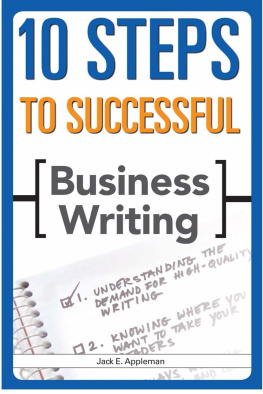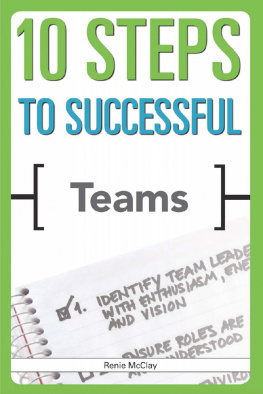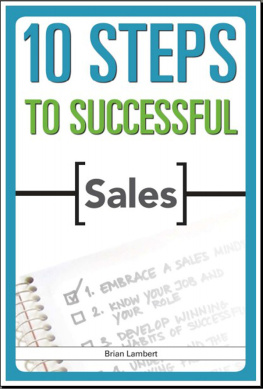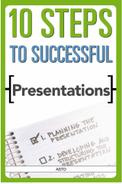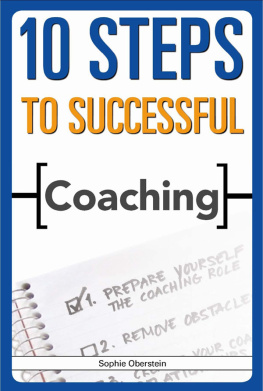Jack E. Appleman - 10 steps to successful business writing
Here you can read online Jack E. Appleman - 10 steps to successful business writing full text of the book (entire story) in english for free. Download pdf and epub, get meaning, cover and reviews about this ebook. City: Alexandria, VA, year: 2009, publisher: Association for Talent Development/ASTD Press, genre: Home and family. Description of the work, (preface) as well as reviews are available. Best literature library LitArk.com created for fans of good reading and offers a wide selection of genres:
Romance novel
Science fiction
Adventure
Detective
Science
History
Home and family
Prose
Art
Politics
Computer
Non-fiction
Religion
Business
Children
Humor
Choose a favorite category and find really read worthwhile books. Enjoy immersion in the world of imagination, feel the emotions of the characters or learn something new for yourself, make an fascinating discovery.
- Book:10 steps to successful business writing
- Author:
- Publisher:Association for Talent Development/ASTD Press
- Genre:
- Year:2009
- City:Alexandria, VA
- Rating:4 / 5
- Favourites:Add to favourites
- Your mark:
- 80
- 1
- 2
- 3
- 4
- 5
10 steps to successful business writing: summary, description and annotation
We offer to read an annotation, description, summary or preface (depends on what the author of the book "10 steps to successful business writing" wrote himself). If you haven't found the necessary information about the book — write in the comments, we will try to find it.
Abstract: Ten steps to successful business writing
10 steps to successful business writing — read online for free the complete book (whole text) full work
Below is the text of the book, divided by pages. System saving the place of the last page read, allows you to conveniently read the book "10 steps to successful business writing" online for free, without having to search again every time where you left off. Put a bookmark, and you can go to the page where you finished reading at any time.
Font size:
Interval:
Bookmark:

2009 the American Society for Training & Development
All rights reserved. Printed in the United States of America. No part ofthis publication may be reproduced, distributed, or transmitted in anyform or by any means, including photocopying, recording, or otherelectronic or mechanical methods, without the prior written permissionof the publisher, except in the case of brief quotations embodied incritical reviews and certain other noncommercial uses permitted bycopyright law. For permission requests, please go towww.copyright.com, or contact Copyright Clearance Center (CCC),222 Rosewood Drive, Danvers, MA 01923 (telephone: 978.750.8400,fax:978.646.8600).
ASTD Press is an internationally renowned source of insightful andpractical information on workplace learning and performance topics,including training basics, evaluation and return-on investment,instructional systems development, e-learning, leadership, and careerdevelopment.
Ordering information for print edition: Books published by ASTDPress can be purchased by visiting ASTDs website at store.astd.org orby calling 800.628.2783 or 703.683.8100.
Library of Congress Control Number: 2007921487 (for print edition only)
Print edition ISBN: 978-1-56286-481-1
PDF e-book edition ISBN: 978-1-60728-269-3
2009-1
| vii |
| 1 |
| 7 |
| 13 |
| 23 |
| 35 |
| 49 |
| 61 |
| 83 |
| 101 |
| 123 |
| 141 |
| 167 |
| 182 |
| 183 |
| 186 |
Lets face it, most people spend their days in chaotic, fast-paced, time-and resource-strained organizations. Finding time for just one more project, assignment,or even learning opportunityno matter how career enhancing or usefulis difficult to imagine. The 10 Steps series is designed for todays busy professional who needs advice and guidance on a wide array of topics ranging from project management to people management, from business planning strategy to decision making and time management, from return-oninvestmentto conducting organizational surveys and questionnaires. Each book in this ASTD series promises to take its readers on a journey to basic understanding, with practical application the ultimate destination. This is truly a just-tell-me-what-to-do-now series. You will find action-driven languageteamed with examples, worksheets, case studies, and tools to help you quickly implement the right steps and chart a path to your own success. The 10 Steps series will appeal to a broad business audience from middle managersto upper-level management. Workplace learning and human resource professionals along with other professionals seeking to improve their value proposition in their organizations will find these books a great resource.
Today, were all writers. Gone, for the most part, are the days when executives dictated letters to secretaries. The vast majority of us write our own documents, thanks to personal computers and email communication, which enable us to create and deliver messages quickly. We generate more documents than ever beforebut we dont do it well.
Study after study point to an inadequate level of writing in the business world. Still, writing typically has been viewed as one of those soft skills that would be nice for employees to improve but not worth the investment of time or money. The prevailing attitude in most companies has been, If we cant measure the benefits in dollars and cents, then why do it? Most companies are more likely to invest in training for sales, project management, budgeting, and other skills that are easier to link to the bottom line than is business writing.
Recently, however, some employers have started to get it: poor writing equals low productivity. The latest studies reveal that employees who write poorly waste countless hours and, more important, countless dollars. These findings have prompted U.S. companies to spend billions of dollars on writing instruction each year.
The good news is that business writing is a learned skill based on fundamental principles like clarity, conciseness, and organization. It doesnt matter how extensive your vocabulary is or what grades you received in high school or college English. If you can learn to convey a message simplyso readers quickly get itthen you can become an effective business writer.
Upgrading writing skills will pay off for you and for employees at every level, from owners and top executives to middle managers and administrative assistants. Those who learn to write better will work more productively and be able to demonstrate leadership and management abilities. Thats why companies and not-for-profit organizations of all sizes should look at ways to improve employees writing skillsthrough tactics such as group workshops, one-on-one coaching, standard writing styles and templates for frequently written documents, and printed or online resources.
A good place to start, whether youre a decision maker or just a working professional, is with 10 Steps to Successful Business Writing, which summarizes the most critical skills for the business writer. Learn these skills and commit to applying them in your documentsand you can improve your writing and your productivity dramatically. Its that simple.
Acknowledgments
Thanks to my wife Rosa for her love, for her strong moral support, and for handling even more household responsibilities during this yearlong project when I spent so many nights stuck in the office, writing. And thanks to my daughters Gail and Sarah for their love, for their support, and for making Rosa and me proud parents.
Jack E. Appleman
January 2008
Successful business writing starts with simplicity. The beauty of simplicity is that it can produce results faster.
A few years ago, a technology firm produced a television commercial for its software consulting services that went something like this: One man (well call him Bob) is speaking in complex technical jargon to explain to another man (lets call him Dave) why their firm should invest in a particular software package. Frustrated with words he doesnt understand, Dave implores Bob to cut the techno-babble and explain the purchase rationale in a way that management could understand. Bob pauses to think about his words; then he says, For every buck we invest, well get back two. So simple, so quick, and so powerful!
Think of some of the most memorable advertising slogans:
- Nike: Just do it.
- State Farm: Like a good neighbor, State Farm is there.
- Subway: Eat fresh.
Those slogans are all so simple, but the advertising agency creative teams probably spent many months and big bucks developing them. Simple isnt always easy. Its like hitting a golf ball: one of the most important skills issimplykeeping your head down during the swing, but so many golfers cant do it consistently.
The good news is that effective business writing doesnt demand that we brainstorm clever slogans or acquire hand-eye coordination. It requires only that we know what we want to say and then choose simple words and follow simple rules.
Why is it so hard to be simple? Too bad that all messages cant be as direct as that TV commercial or those popular slogans. Consider these messages I recently received while battling my personal computer:
- Avsynmgr has caused an error in MCSCAN32DLL. The application will close.
Oh, I get it. I knew I should have paid more attention to my
Font size:
Interval:
Bookmark:
Similar books «10 steps to successful business writing»
Look at similar books to 10 steps to successful business writing. We have selected literature similar in name and meaning in the hope of providing readers with more options to find new, interesting, not yet read works.
Discussion, reviews of the book 10 steps to successful business writing and just readers' own opinions. Leave your comments, write what you think about the work, its meaning or the main characters. Specify what exactly you liked and what you didn't like, and why you think so.

